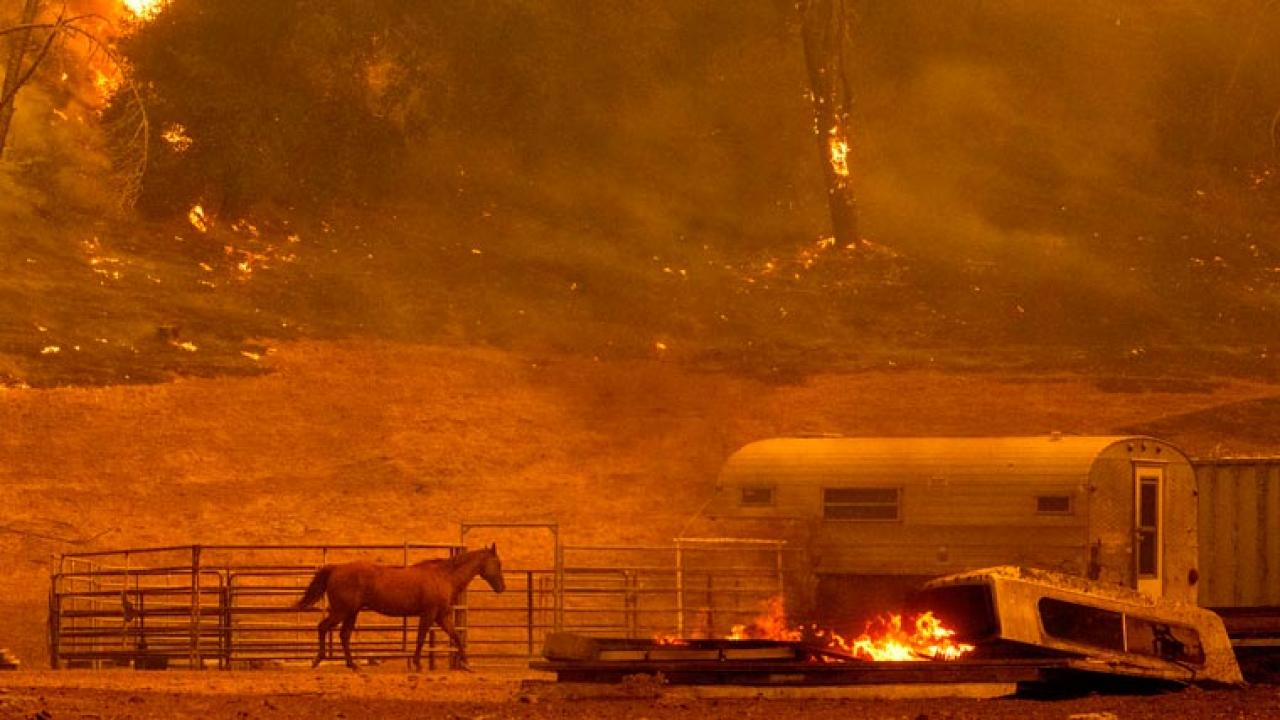
Teams Shelter, Treat Animals in Record Fire Season
by Greg Cima for JAVMA News
Wildfires burned across the Western U.S. in August and September, killing at least 35 people and destroying more than 5,800 buildings.
At press time, tens of thousands of firefighters were battling massive fire complexes in California, Oregon, and Washington state and extinguishing dozens of new fires each day. Veterinarians on emergency response teams treated injured animals, helped find and evacuate those in danger, and monitored animals staying on pastures after their owners evacuated.
In California, the August and early September fires alone had burned 3 million acres, exceeding the record for all previous years with four months still left in the fire season. In Oregon, state authorities gave a half-million people notice to prepare for evacuation, and 40,000 had already fled.
At least 24 people died in California, eight in Oregon, and one in Washington state. In Oregon, another 22 people were missing at press time.
Colorado firefighters also were battling four large blazes, some of which were spreading with little to no containment. Other fires burned in Arizona, Idaho, Montana, Nevada, New Mexico, and Utah, according to the National Wildfire Coordinating Group.
Climate change contributes to fires
Record-breaking heat over Labor Day weekend, thousands of lightning strikes, ample stands of dead trees, and a rare windstorm in Oregon’s Cascade foothills all contributed to blazes, according to information from state fire authorities and federal climate officials.
“The timing of the windstorm was unusual because those strong east winds usually occur in the dead of winter—not in early September,” information from NASA’s Goddard Space Flight Center states. “In addition to the heat, it is another example of the changing weather patterns that are being seen.”
By Sept. 11—only a few days into Oregon’s intense fires—about 2,500 pets, horses, and livestock were sheltered in county fairgrounds across the state, said Andrea Cantu-Schomus, spokesperson for the Oregon Department of Agriculture. Authorities in 16 counties had facilities sheltering animals, and two counties placed animals in foster homes.
Members of the Veterinary Emergency Response Team from the University of California-Davis School of Veterinary Medicine examined and treated animals in response to two fire complexes in August and September. And more than 90 volunteers from the Oregon State University Carlson College of Veterinary Medicine worked at the nearby Benton County Fairgrounds and a shelter in neighboring Linn County to examine and treat animals brought from two large fires to the northeast and southeast.
The American Red Cross reported Sept. 18 that the organization and its partners had provided 8,000 people emergency lodging, at hotels when possible and shelters when needed. People who evacuated with pets but were unable to get into hotel rooms found accommodations through the Red Cross’ partner organizations. Red Cross shelters had limited space for people to reduce the risk volunteers or residents will develop COVID-19.
Greta Gustafson, a spokeswoman for the Red Cross, said the organization was working with community partners to find shelters and resources for pets while maintaining safety for people in Red Cross shelters.
Sheltering animals in California
Dr. Lais Costa, coordinator for the Veterinary Emergency Response Team at UC-Davis, said her teams responded to the LNU Complex fire by working at emergency animal shelters that needed help, aiding animal control officers on search and rescue missions, and checking on animals remaining at homes and farms after their owners evacuated.
From Aug. 19-27, UC-Davis veterinarians, veterinary technicians, and veterinary students delivered hands-on examinations to about 500 animals in the field. Of those, 14 required minor treatments, such as injections or bandage changes, Dr. Costa said. About a dozen animals had burn injuries, including six chickens treated at shelters.
Another 35 were treated at the UC-Davis Veterinary Medical Teaching Hospital, according to university data. Those animals were 11 alpacas, six horses, six goats, five sheep, three cats, three llamas, and one tortoise.
About a dozen donkeys and sheep were found dead, Dr. Costa said.
Most animals at their homes and emergency shelters appeared to be healthy, injury free, and not overly distressed, Dr. Costa said.
“Most of the animals were evacuated before the fire really had gotten to them,” she said.
UC-Davis team members deployed again Sept. 13 in response to the North Complex Fire north of Sacramento. By Sept. 15, they rescued, examined, or treated 650 animals in response to that fire as well as treated another 12 at the hospital.
Dr. Claudia Sonder, who is an equine veterinarian and president of the Napa County Animal Response Team in California, said Sept. 8 her organization had moved beyond the around-the-clock response from the first 72 hours of the LNU Complex fire and into a recovery phase, helping animal owners get feed, husbandry supplies, and veterinary care.
Data provided by Dr. Sonder indicate two shelters from the Napa Valley Horseman’s Association and Valley Brook Equestrian Center housed 128 horses and 64 livestock over two weeks. The response team also transported eight animals to veterinary hospitals: three horses, two cats, a duck, a goat, and a pig.
Thirty-three horses required some veterinary care—15 for gastrointestinal issues, 12 for wounds, two for chronic lameness, two that received only sedatives, and one each for eye injury and hives.
The responders euthanized three horses for their severe burns and one for end-stage musculoskeletal disease, the data show.
Dr. Sonder said the volunteers also sent some large animals to UC-Davis for burns or thermal injuries to their eyes. But the most common ailments in large animal emergency shelters tended to be colic—which is exacerbated by stress, confinement, and new diets—followed by lacerations from transportation or flailing in the close confinement of a shelter.
As of Sept. 14, the California VMA’s California Veterinary Medical Reserve Corps stood ready to help if called.
